Have you ever heard of Hachi? Perhaps you know him by his full name, Hachiko, the legendary Akita dog whose story of unwavering loyalty has captivated hearts worldwide. Before we visited Japan for the first time, we hadn’t either, but it’s a tale you’re bound to encounter when exploring the vibrant culture of this incredible country. Hachiko isn’t just a local legend; he’s a national hero, inspiring multiple films, including the poignant Hollywood adaptation, “Hachiko – A Dog’s Story.” This remarkable dog even has his own bronze statue outside Shibuya Train Station in Tokyo, where countless visitors pose for photographs daily, a testament to his enduring legacy.
The fame of this incredible canine stretches across oceans, with a replica of his iconic Shibuya statue located at Woonsocket Depot Square in Rhode Island, USA—the very setting for the “Bedridge” train station featured in the American film. You might wonder, why is Hachi The Real Story so famous, so deeply embedded in global consciousness? You’ve come to the right place. We’re about to delve into the amazing, real, and profoundly moving tale of Hachiko, a dog whose devotion knew no bounds. Prepare to be touched by a narrative that embodies the true spirit of canine companionship, a bond that transcends life itself.
The Humble Beginnings of a Legend: Hachi’s Early Life
Professor Hidesaburō Ueno, an esteemed agricultural science professor at The University of Tokyo, harbored a deep desire for a purebred Japanese Akita dog. His search for the perfect puppy spanned a considerable period until one of his students presented him with an opportunity: a puppy discovered in Odate City, located in the northern Akita prefecture of Japan.
Born on November 10, 1923, on a farm in Odate, this special puppy was a purebred Akita, sired by Oshinai (named after the region) and Goma (meaning “sesame”). Professor Ueno purchased him for ¥30, a significant sum at the time, and the young Akita puppy began a challenging 20-hour train journey to Tokyo. Upon his arrival at Professor Ueno’s home on January 15, 1924, the puppy was in critical condition, initially mistaken for deceased. According to Professor Mayumi Itoh’s biography of Hachiko, Professor Ueno and his girlfriend, Yae, diligently nursed the fragile puppy back to robust health over the following six months.
Professor Ueno bestowed upon his new companion the name “Hachi,” which translates to “eight” in Japanese—a number widely considered lucky in Japan. From that moment, Hachi and his owner forged an unbreakable bond. Professor Ueno cherished Hachi above all, treating him as his own son, and the two became utterly inseparable. Their story is a powerful reminder of the profound connection between humans and their pets, a theme explored in many animal narratives, similar to [toby's story a dog's purpose puppy tale](https://dogcarestory.com/tobys-story-a-dogs-purpose-puppy-tale/), where a dog’s journey is deeply intertwined with human lives.
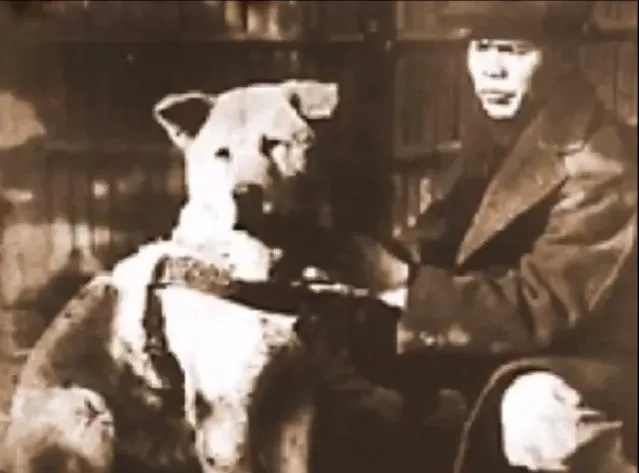 Hachiko with his devoted owner Professor Ueno in a heartwarming portrait, highlighting their strong bond
Hachiko with his devoted owner Professor Ueno in a heartwarming portrait, highlighting their strong bond
Daily Rituals and a Profound Bond
As Hachi matured, he developed a unique and heartwarming routine. Each morning, he would faithfully accompany Professor Ueno to Shibuya Train Station in central Tokyo, seeing him off to work. And every afternoon, precisely when his owner’s train was due, Hachi would return to the station, waiting patiently to greet him and escort him home. This daily ritual wasn’t just a habit; it was a testament to the extraordinary love and connection shared between the professor and his loyal companion.
Tragically, on May 21, 1925, just two years after Hachi’s birth, Hachi took his usual spot by the Shibuya Station exit, his tail undoubtedly wagging in anticipation for Professor Ueno. But that afternoon, his beloved owner never emerged from the train. Unbeknownst to Hachi, Professor Ueno had suffered a sudden and unexpected cerebral hemorrhage while at work, passing away at the age of 53. Hachi had been by the professor’s side for a year and four months, a period that forged a bond strong enough to defy even death.
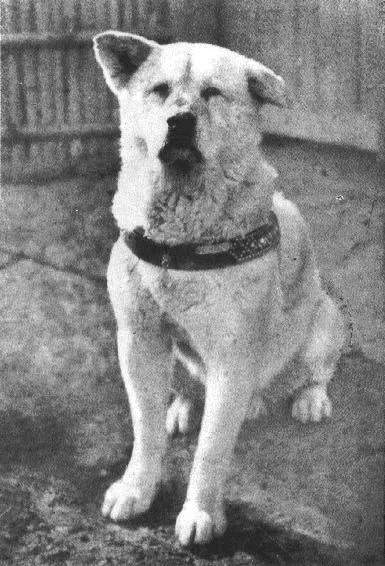 Hachiko, a magnificent purebred Akita dog, posing for a photograph, showcasing his dignified stature
Hachiko, a magnificent purebred Akita dog, posing for a photograph, showcasing his dignified stature
Hachi subsequently moved in with Kozaburo Kobayashi, a former gardener for the Ueno family. Yet, for the remainder of his ten-year life, Hachi’s unwavering devotion compelled him to return to Shibuya Train Station every single afternoon. He would sit for hours, patiently waiting for the return of his cherished friend, a friend who, heartbreakingly, would never come back. Professor Itoh beautifully captures this enduring vigil in Hachiko’s biography, noting, “In the evening, Hachi stood on four legs at the ticket gate and looked at each passenger as if he were looking for someone.“
Hachi’s new home in Tomigaya was conveniently close to Professor Ueno’s former residence, allowing him easy daily access to Shibuya Station. Sadly, not everyone treated Hachi with the kindness he deserved during his long waits. There are accounts of him being subjected to mistreatment and bullying by passersby, station staff, and even children. This harsh reality began to shift dramatically when his story was serendipitously picked up by a Japanese newspaper.
Hachi: From Local Curiosity to National Hero
In 1932, a reporter for a major Japanese newspaper discovered Hachi’s poignant story and published it, transforming Hachi from a local curiosity into a national celebrity. The article resonated deeply with the Japanese public, who began referring to him as “Chuken-Hachiko,” which translates to “Hachiko – the faithful dog.”
The narrative of this dog, who never gave up hope, captured widespread attention across national media. It inspired countless people from around the world to visit Shibuya Train Station, bringing treats and comfort to Hachiko. He profoundly touched the hearts of the Japanese people, swiftly becoming a cherished hero and an enduring symbol of unwavering loyalty. For those fascinated by heartwarming dog stories and profound canine bonds, exploring narratives like [dog's purpose puppy tales](https://dogcarestory.com/dogs-purpose-puppy-tales/) offers further insights into the special relationships we share with our pets.
Hachiko maintained his daily vigil outside Shibuya Station, waiting for his deceased friend and master, precisely when Professor Ueno’s train was scheduled to arrive. This incredible display of fidelity continued for an astounding nine years, nine months, and 15 days, until Hachi himself passed away peacefully on March 8, 1935, at the age of 11. It’s no wonder that even today, his hachi the real story continues to serve as a powerful emblem of love, devotion, and profound loyalty.
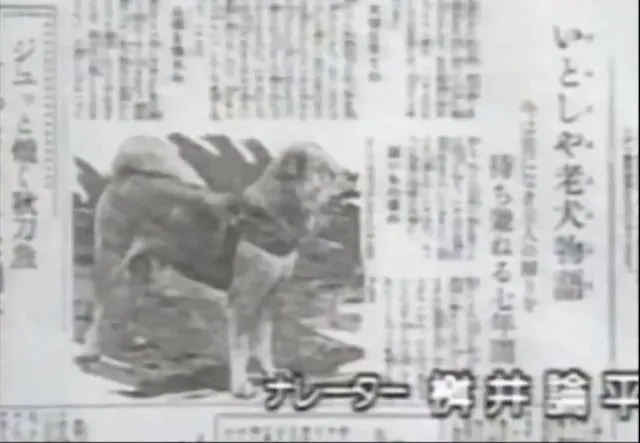 Hachiko featured prominently in a Japanese newspaper, highlighting his widespread fame and the impact of his story
Hachiko featured prominently in a Japanese newspaper, highlighting his widespread fame and the impact of his story
Hachiko’s Enduring Legacy: Statues and Memorials
Hachiko’s story of loyalty has transcended time and continues to inspire, immortalized through various statues and monuments across Japan. There are currently five prominent Hachiko statues and memorials in Tokyo alone, each a tribute to his remarkable spirit.
The Iconic Shibuya Station Hachiko Statue
The most renowned and frequently visited Hachiko statue stands proudly in front of Shibuya Station in central Tokyo. This initial sculpture was erected in 1934 by the Japanese artist Teru Andō. Its unveiling was a grand ceremony held directly outside Shibuya train station, with Hachiko himself present as the guest of honor.
![]() Hachiko himself standing proudly in front of his iconic bronze statue at Shibuya Station, a truly historic moment
Hachiko himself standing proudly in front of his iconic bronze statue at Shibuya Station, a truly historic moment
Today, the Hachiko bronze statue at Shibuya Station is one of Tokyo’s most significant tourist attractions and a beloved meeting point, especially among young Japanese. It embodies the essence of [hachi a dog's tale true story](https://dogcarestory.com/hachi-a-dogs-tale-true-story/), drawing visitors from all over the world to witness this symbol of devotion.
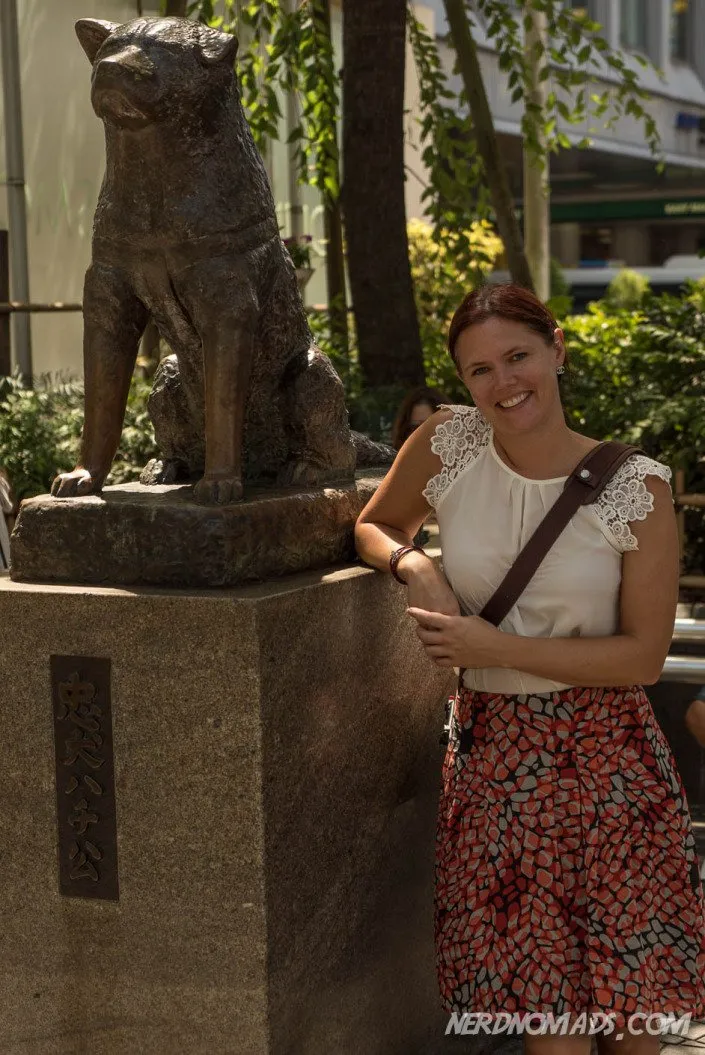 Hundreds of people gather around the Hachiko statue at Shibuya Station, highlighting its popularity as a meeting point
Hundreds of people gather around the Hachiko statue at Shibuya Station, highlighting its popularity as a meeting point
Interestingly, there have been two Hachiko bronze statues at Shibuya Station over the years. The original was removed and melted down during World War II to supply metal for the war effort. The current Hachiko statue, a faithful recreation, was crafted in 1948 by Takeshi Ando, the son of the original artist. If you visit the statue, you’ll notice that the adjacent station exit is aptly named “Hachikō-guchi,” meaning “The Hachikō Entrance/Exit” in English—one of Shibuya Station’s five exits.
Every year, on March 8th, the anniversary of Hachiko’s passing, a moving memorial ceremony is held at Shibuya Station, honoring Hachi’s enduring spirit of love and loyalty. The 2023 ceremony was particularly significant, marking what would have been Hachiko’s 100th birthday, drawing a large and respectful crowd.
“Hachiko Family” Mosaic at Shibuya Station
Beyond the bronze statue, a magnificent mosaic artwork titled “Hachiko Family” adorns the wall of Shibuya Station. This beautiful mural depicts Hachiko playing joyfully with his parents and siblings, offering a heartwarming glimpse into his imagined family life. Created by the Japanese artist Ryutaro Kitahara, it was completed in March 1990.
A poem by Kitahara Ryutaro, titled “Let’s Meet in Front of the Mural,” accompanies the artwork:
“It is a place of hellos and goodbyes of happiness and sadness It is the fashionable square where people gather It is the square where you feel the joy of living Let’s talk about your and my happiness Let’s meet in front of the “Hachiko Family” mural“
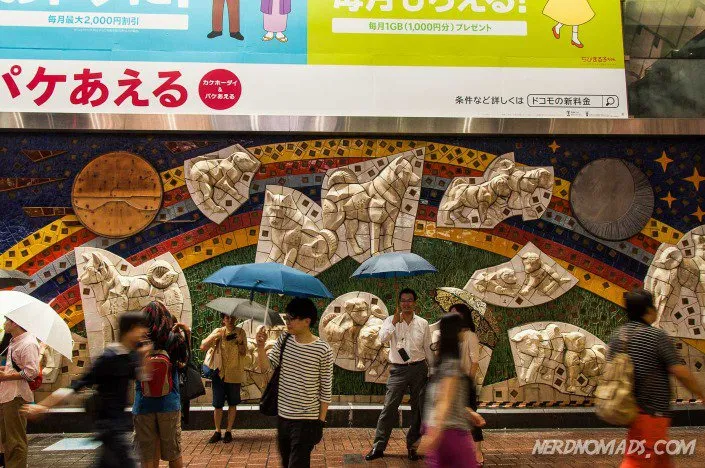 Beautiful mosaic artwork of Hachiko with his family at Shibuya Train Station, Tokyo, capturing a heartwarming scene
Beautiful mosaic artwork of Hachiko with his family at Shibuya Train Station, Tokyo, capturing a heartwarming scene
Hachiko Preserved: National Museum of Nature and Science
Hachiko peacefully passed away alone on a street near Shibuya Train Station on March 8, 1935, at the age of 11. Given his immense symbolic status as a beacon of loyalty and devotion in Japan, Hachiko was preserved and stuffed. Today, visitors can encounter the preserved Hachiko at the National Museum of Nature and Science in Ueno, Tokyo, a profound experience for anyone touched by his true story.
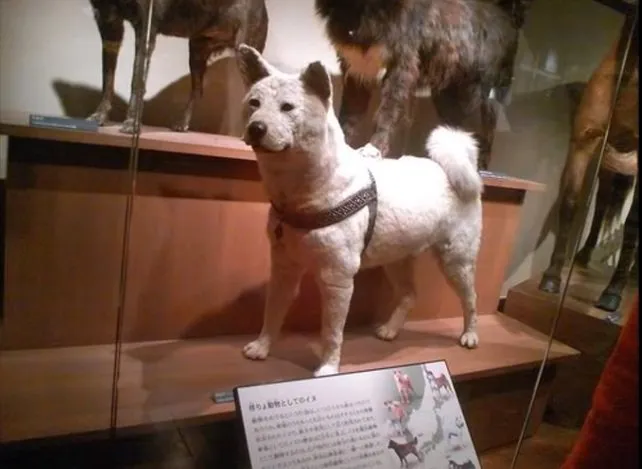 The preserved Hachiko on display at the National Museum of Nature and Science in Ueno, Tokyo
The preserved Hachiko on display at the National Museum of Nature and Science in Ueno, Tokyo
The Touching Reunion: Hachiko & Professor Ueno Statue at University of Tokyo
At the University of Tokyo, a poignant bronze statue portrays Hachiko in a joyful reunion with his best friend and owner, Professor Hidesaburō Ueno. This university was Professor Ueno’s workplace, where he served as a professor of Agricultural Science, and tragically, where he suffered the cerebral hemorrhage that left Hachiko alone.
This particular statue is often considered the most moving, depicting a hearty reunion between Hachiko and Hidesaburō. Nestled under a large tree, it emanates a sense of peace and reflection. A nearby bench invites visitors to pause and contemplate themes of loyalty, love, and devotion. Unlike the bustling Shibuya location, this spot offers a quieter, more intimate experience, allowing for unhurried contemplation.
Erected on March 9, 2015, on the 80th anniversary of Hachiko’s death, this statue was crafted by the Japanese artist Tsutomo Ueda from Nagoya. It beautifully captures Hachiko leaping to greet Hidesaburō at the end of a workday, a truly adorable and emotionally resonant depiction.
Adjacent to the statue, a small museum offers further insights into Hachiko’s life. Here, you can view a display of articles and photos, his autopsy report, and even some of his preserved entrails. The autopsy revealed that Hachiko died of terminal cancer and a filaria infection. Interestingly, four yakitori skewers were also found in his stomach, though they did not cause any damage or contribute to his death. For those with a strong interest in anatomical preservation, Hachiko’s liver, heart, and lung are on display at this small museum within the University of Tokyo’s Faculty of Agriculture, near Ueno Park.
A Final Resting Place: Hachiko Monument at Ueno’s Grave
While Hachiko’s fur was preserved for the museum, his remains were cremated. His ashes were then interred alongside his beloved friend and owner, Professor Ueno, in Aoyama Cemetery in Minato, Tokyo. Visitors can pay their respects at his grave, where a monument dedicated to Hachiko stands proudly beside his owner’s tomb, forever uniting the faithful dog with his master.
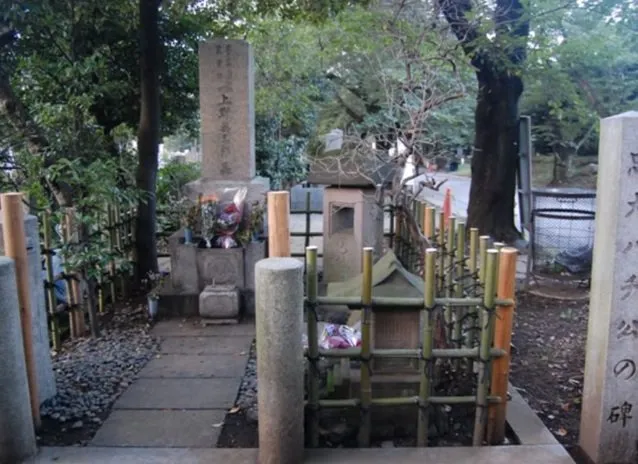 The solemn monument of Hachiko placed next to his owner's tomb in Aoyama Cemetery, symbolizing their eternal bond
The solemn monument of Hachiko placed next to his owner's tomb in Aoyama Cemetery, symbolizing their eternal bond
Beyond Tokyo: The Akita Hachiko Dog Museum in Odate City
For a truly immersive experience into the world of the Akita breed and Hachiko’s origins, a visit to the Akita Hachiko Dog Museum in Odate City is a must. Located in the Akita prefecture of Japan, this museum pays homage to the world’s most famous Akita dog. It offers a comprehensive journey through the history and characteristics of the Akita dog, with a special focus on hachi the real story.
Animal lovers will find this museum particularly engaging. On weekdays, visitors even have the unique opportunity to meet and interact with two adorable Akita dogs inside the museum, providing a delightful and interactive experience. The museum operates daily from mid-April to mid-November, between 9:00 AM and 4:00 PM.
Odate City, where the museum is situated, is often regarded as the “capital city” of the Akita dog breed. The city proudly displays numerous Akita dog statues and symbols throughout its streets. You’ll find another Hachiko statue in front of Odate Station, a dedicated Hachiko Shrine on the train platform, and an Akita dog figure adorning the top of the postbox at City Hall. Even the city’s manhole covers are intricately decorated with Hachiko-related cartoon characters, making every step an opportunity to discover a tribute to this beloved canine hero.
- Address: 13-1 Aza Sannomaru Ōdate City, Akita, Japan
- Opening hours: mid-April to mid-November, between 09:00 (9 am) and 16:00 (4 pm)
- Webpage of the Akita Haciko Dog Museum
Hachi’s Story on Screen and Page
The incredible loyalty of Hachiko has inspired creators across various mediums, bringing his poignant story to a wider audience.
Hachiko on Film
In 1987, Japan produced its own cinematic tribute, “Hachiko Monogatari,” a powerful portrayal of the dog’s life. Years later, Hollywood brought a fresh interpretation to the screen with the 2009 American film, “Hachi: A Dog’s Tale.” This adaptation, starring Richard Gere, moved audiences globally, solidifying Hachiko’s status as a universal symbol of devotion. If you haven’t seen the movie [hachiko a dog's story 2009](https://dogcarestory.com/hachiko-a-dogs-story-2009/), be prepared with tissues; it’s a truly emotional experience. The film was primarily shot in Rhode Island, USA, where a statue of Hachi now stands proudly in front of the local train station, commemorating the story’s American setting.
Books About Hachiko
Beyond the silver screen, several compelling books have been written about Hachiko and his extraordinary life. These literary works delve deeper into the nuances of his story, offering different perspectives and rich historical context. For those who wish to immerse themselves further in his legend, these books provide a wonderful way to connect with Hachiko’s enduring spirit.
Furthermore, the affection for Hachiko extends to adorable merchandise, with many fans loving the Hachiko Akita teddies, a tangible reminder of this beloved dog.
Planning Your Hachiko Pilgrimage to Tokyo
For enthusiasts of Hachiko’s story, Tokyo offers a unique pilgrimage. Make sure to visit the iconic Hachiko Statue at Shibuya Train Station, pay your respects at the monument of Hachiko next to his owner’s tomb in Aoyama Cemetery, and experience the preserved Hachiko himself on display at the National Museum of Nature and Science in Ueno. Each location offers a tangible connection to hachi the real story and the profound legacy he left behind.
Tokyo, a city of endless wonders, provides a diverse range of accommodation options to suit every traveler. From luxurious hotels to traditional Japanese inns, capsule hotels, and budget-friendly choices, you’ll find the perfect place to rest after your Hachiko-inspired explorations.
For a top-tier experience, The Park Hyatt, famously featured in “Lost in Translation,” offers spacious rooms, legendary service, and the world-renowned New York Bar Grill with stunning city views. Alternatives include the elegant Palace Hotel Tokyo and The Tokyo Station Hotel.
Mid-range options like Tokyu Stay Shinjuku offer convenience and comfort, with amenities like washing machines in rooms. Hotel MyStays Asakusabashi is another excellent choice, known for its decent-sized rooms and a lively neighborhood with plenty of dining options.
For solo travelers on a budget, MyCube by MyStays provides a modern and spacious capsule hotel experience, complete with lockable baggage storage and free Wi-Fi, conveniently located near a subway station. Khaosan Asakusa Hostel is another great budget alternative.
Conclusion
The story of Hachiko is far more than just a tale of a dog; it’s a timeless testament to the enduring power of loyalty, love, and the unbreakable bond between humans and their animal companions. Hachi the real story resonates deeply because it exemplifies the purest form of devotion, a steadfastness that continued long after his beloved owner, Professor Ueno, was gone. Hachiko’s decade-long vigil at Shibuya Station transformed him into an international icon, a symbol reminding us of the profound emotional intelligence and unwavering faithfulness that dogs bring into our lives.
His legacy lives on, not just in bronze statues and museum exhibits, but in the hearts of everyone who hears his story. Hachiko reminds us that dogs truly are man’s best friend, capable of a love so profound it leaves an indelible mark on the world. We encourage you to reflect on Hachiko’s incredible journey and cherish the unique bond you share with your own pets. To explore more heartwarming canine tales and insights into their remarkable lives, discover other stories like [hachi a dogs tale 2009](https://dogcarestory.com/hachiko-a-dogs-tale-2009/) on our site.
